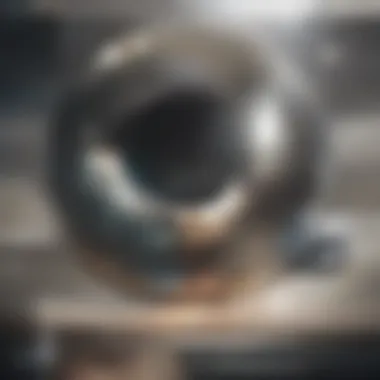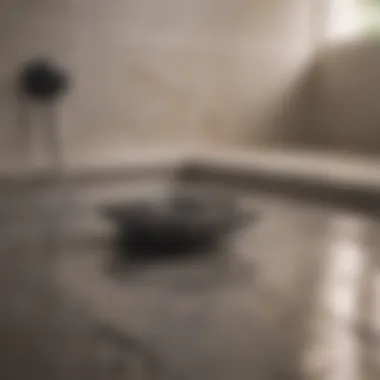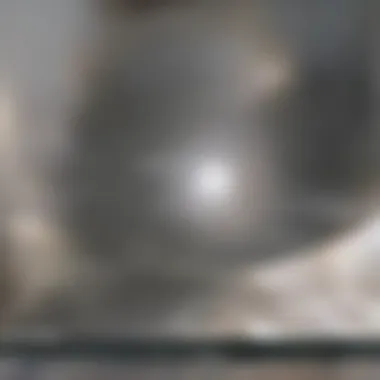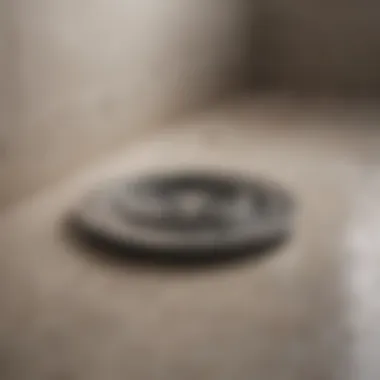A Comprehensive Guide to Installing a Shower Drain


Intro
Ensuring effective drainage in a shower is a vital part of bathroom construction. A poorly installed shower drain can lead to serious problems, such as leaks and water damage. As homeowners seek greater functionality and aesthetics in their bathrooms, the importance of a well-installed shower drain cannot be overstated. This guide provides a blend of practical advice and technical know-how, targeting both DIY enthusiasts and professionals.
We shall outline the necessary tools and materials, as well as important codes and regulations that should guide the installation process. With a structured approach, install a shower drain can become a manageable task.
Key Points to Discuss
- Essential tools and materials for the installation.
- Step-by-step instruction for a successful installation.
- An overview of relevant codes and regulations.
- Tips for avoiding common pitfalls within the process.
This comprehensive guide aims to arm readers with knowledge, thus enhancing the efficiency and quality of their shower drain installations.
Understanding Shower Drains
The shower drain is a critical element in bathroom plumbing. Understanding shower drains is vital for ensuring proper water management in your home. This section discusses various aspects of shower drains including their types and components, which ultimately contribute to effective installation and maintenance. Without proper knowledge about them, one might face issues like unpleasant odors or water pooling. It encourages homeowners and professionals to consider the practical benefits of selecting an appropriate drain and understanding its structure.
Types of Shower Drains
When choosing a shower drain, various types come into play. The most common types include:
- Standard Floor Drains: These are generally round and fit most shower layouts. They offer reliable drainage for average use.
- Linear Drains: These have a rectangular shape and are often installed at the shower's edge. They are ideal for larger areas, providing a sleek and modern appearance.
- Point Drains: These drains are designed for smaller bathrooms and focus on a single point for water collection.
The type of drain you select can greatly influence the overall aesthetics and function of the shower space. For instance, linear drains can improve drainage speed and are often favored in contemporary designs.
Shower Drain Components
Every shower drain consists of several components that work together to manage water flow effectively. Key parts include:
- Drain Body: This is the core of the drainage system, connecting to the plumbing. It is crucial for effective water management.
- Strainer: The strainer is placed to catch hair and debris, preventing clogs.
- Trap: A trap holds a small amount of water to create a barrier against sewer gases, ensuring that the bathroom remains free of unpleasant odors.
- Screws and Flanges: These secure the strainer and body together, providing structural stability.
Each of these components plays a significant role in preventing drainage issues. Being aware of these parts can help you make informed choices when selecting and installing a shower drain.
Planning for Installation
Planning for the installation of a shower drain is a crucial step that influences the overall effectiveness and longevity of the setup. This segment involves various elements that warrant careful consideration. The drain’s location, the measurements taken, and the overall layout must align cohesively to ensure functionality and prevent future complications.
- Importance of Drain Placement:The positioning of the shower drain affects water flow and drainage efficiency. A poor location can lead to standing water, giving rise to mold and mildew growth. Therefore, selecting an optimal drain location is indispensable. It is often advisable to choose a spot near the showerhead or faucet, which aids in proper drainage without water pooling.
- Evaluating Bathroom Layout:The layout of the bathroom should be assessed comprehensively. Features such as existing plumbing, floor slope, and access to the drainage system must be factored in. This ensures that the installation process is not only straightforward but also adheres to the plumbing codes, which vary by region.
- Benefits of Detailed Planning:Taking the time to plan the installation can save resources in the long run. Avoiding potential miscalculations will prevent unnecessary costs stemming from repairs and adjustments. Additionally, certified regulations often require that installations meet specific guidelines for drainage systems, which further underlines the need for precise planning.
- Planning Tools and Resources:Utilizing software or drawing tools to draft the layout can be helpful. Such tools allow you to visualize the space and understand where the drain will be optimally positioned. A layout that outlines the slope and connections helps in comprehending what equipment will be necessary.
"A well-thought-out plan is the foundation for a successful shower drain installation. Misplacement can lead to excessive problems down the line."
Materials Needed for Shower Drain Installation
The materials used in a shower drain installation are critical for the effectiveness and longevity of the system. Understanding the right materials ensures a proper setup, reduces maintenance issues, and enhances overall functionality. The main components include the drain itself, pipes, and various sealing materials. Choosing high-quality materials can prevent future leaks and costly repairs. Moreover, depending on the drain design, there are specific requirements for materials that align with local building codes. This section outlines these essential materials, providing clarity on their roles and significance.
Drain Types and Materials
There are several types of shower drains, each coming with its unique materials. The most common types include:
- Point drains: These are the traditional style, installed at a single spot on the floor. They typically require a metal or plastic body, and options like stainless steel or PVC can be suitable for durability against water exposure.
- Linear drains: These drains provide a modern aesthetic and are often used in larger shower spaces. They are available in materials such as aluminum or stainless steel. Linear drains can also be customized in length, offering flexibility in placement.
When selecting drainage materials, consider:
- Durability: Ensure materials can withstand moisture and wear. Stainless steel is often recommended for its rust resistance.
- Compatibility: The drain must match the pipe size and system installed in your home.
- Aesthetic Appeal: Choose materials that fit with overall bathroom design.
Proper selection of the drain type and its materials contributes significantly to the efficiency of the drainage system.


Recommended Adhesives and Sealants
Using the right adhesives and sealants is paramount during the installation process. These materials serve to prevent leaks and ensure a solid connection between all components. Here are some common recommendations:
- Silicone Sealant: This is a versatile option, ideal for sealing gaps and providing a waterproof barrier. It is flexible, allowing for some movement without cracking.
- PVC Cement: Only applicable if your drain and pipes are PVC. This cement bonds the materials strongly and ensures sealed joins.
- Thread Seal Tape: This is useful for threaded connections to prevent leaks. It’s important to apply it properly, ensuring no gaps or inconsistencies remain.
Important considerations when choosing adhesives and sealants:
- Water Resistance: Ensure that the products are specifically formulated for use in wet areas.
- Longevity: Consider products that have been tested for endurance in harsh conditions.
- Compatibility: Ensure that chosen adhesives work with the materials of your drains and pipes.
Using inappropriate adhesives can lead to future leaks, causing damage to the flooring and overall structure of the shower area.
In summary, paying attention to the materials used for drain types, along with the appropriate adhesives and sealants, is essential in installing a shower drain. These choices directly impact the efficiency, maintenance, and aesthetics of your shower.
Essential Tools for Installation
When it comes to installing a shower drain, having the right tools is crucial. The success of your project largely depends on being prepared with the necessary equipment. Utilizing appropriate tools ensures efficiency, minimizes the risk of errors, and helps achieve a professional finish. Different types of tools fulfill various roles in the installation process, ranging from basic hand tools to more advanced power tools.
Basic Hand Tools
Basic hand tools form the foundation of any installation task. These tools are essential for precise work and manual adjustments. Some critical hand tools you will need include:
- Adjustable Wrench: This tool is vital for tightening nuts and fittings that secure the drain.
- Pipe Cutter: For cutting pipes to the correct length, a pipe cutter ensures clean edges for a better seal.
- Screwdriver Set: A screwdriver will assist in installing screws or anchors needed for the drain.
- Pliers: Pliers help provide grip and leverage while working with the various fittings.
Using high-quality hand tools can increase safety and improve the efficiency of your work.
Power Tools for Efficiency
Power tools can significantly enhance the installation process, allowing for more complex tasks to be completed with less effort. They can save time and facilitate precision. Some notable power tools to consider are:
- Cordless Drill: This is necessary for drilling holes into tiles or concrete for mounting the drain securely. It also works well for fastening screws into place.
- Angle Grinder: This tool is used for grinding and cutting, especially if adjustments need to be made to existing materials.
- Sawzall: A reciprocating saw can be handy for cutting through pipes or other materials quickly.
Power tools can lead to improved accuracy and reduced workload, making them an invaluable addition to your toolbox.
"Investing in quality tools makes a significant difference in the installation process, ensuring durability and proper fit of the shower drain."
Having these tools available can not only ease the installation but also reduce the potential for damage or mistakes. When starting your project, make sure all tools are readily accessible and in good working condition. This preparation sets the stage for a successful installation.
Preparing the Shower Base
Preparing the shower base is a crucial step in the shower drain installation process. A well-prepared base ensures that the drain functions correctly and that water flows properly without issues. If the base is not properly prepared, it can lead to drainage problems, unwanted pooling, and even leaks, which might require extensive repairs later on. Attention to detail in this phase can significantly affect the overall quality of the installation.
Clearing and Cleaning the Area
Before you start, it is important to clear and clean the area where the shower base will sit. This involves removing old tiles, debris, or any other materials that could interfere with the new installation. A clean area will not only promote good adhesion of materials but also allows for accurate measurements.
It is wise to use a vacuum or a broom to remove any dust and loose particles. Pay special attention to corners and edges where dust tends to accumulate. Once cleared, inspect the underlying surface for any damages or irregularities. This step is vital because any existing issues may affect how the new shower base sets.
Creating a Solid Foundation
After clearing the space, creating a solid foundation is the next logical step. A stable and level foundation supports the weight of the shower base and ensures proper slope for drainage.
Begin by analyzing the subfloor condition. If it is damaged, consider making repairs or replacing sections as needed. Once the subfloor is assessed, applying a layer of mortar or a pre-sloped shower pan can provide the necessary slope for water drainage towards the drain.
In addition to installing a sloped surface, consider reinforcing the area with plywood if the base feels flimsy. This extra support is critical to prevent sagging or movement over time, which can lead to future drainage problems.


A proper foundation is key to a leak-free shower installation. Neglecting this step can lead to costly repairs later.
The Installation Process
The installation of a shower drain is a crucial aspect of ensuring a bathroom is both functional and efficient. As this guide underscores, the installation process is not merely about placing a drain; it involves precise measurements, careful planning, and an understanding of materials and tools involved. A well-installed drain prevents leaks and stands the test of time, enhancing the overall value of a property.
In this section, we will discuss three key steps in the installation process: cutting the drain hole, positioning the drain correctly, and securing the drain to guarantee a leak-free seal. Each step requires attention to detail and adherence to best practices to achieve a successful installation.
Cutting the Drain Hole
Cutting a precise hole for the drain is fundamental to any shower installation. First, it’s essential to select the right location based on the layout of the shower base and, importantly, the plumbing configuration beneath. Use a pencil to mark where the drain will sit, ensuring it aligns with the shower’s slope toward the drain. This slope is necessary for effective water removal.
When cutting the hole, utilize a jigsaw or hole saw with a blade appropriate for the material of the shower base, be it tile, fiberglass, or another substrate. How to cut the hole:
- Mark the center of the drain on the shower base.
- Use a level to ensure the slope toward the drain meets local code requirements.
- Cut the hole cleanly to avoid jagged edges.
Remember to wear personal protective equipment like goggles and gloves.
Positioning the Drain
Positioning the drain correctly is several steps in the installation process. After cutting the hole, the next step is to place the drain body into the hole. This task requires you to align the drainage pipe with the drain body. The drain needs to fit snugly but also needs to be adjustable for any future modifications.
Considerations for positioning:
- Ensure the drain grate fits well with the shower’s layout.
- Confirm that the adjustable drain can accommodate variances in the floor height.
- Check the alignment with the existing plumbing; it should lead directly to the main waste line.
Being careful during this step can save time and prevent costly adjustments later.
Securing the Drain
Once positioned, securing the drain is the final crucial aspect of this process. Begin by applying a layer of waterproof adhesive around the perimeter of the drain. Then, carefully place the drain back into the hole, ensuring it adheres to the surface below.
Follow these steps to secure:
- Use screws to fasten the drain flanges into the shower base.
- Ensure that the connection between the drain and the waste pipe is tight. Use a plumbing slip joint if necessary.
- Apply a sealant around the edge to ensure no water can escape.
"A well-secured shower drain not only enhances functionality but also prevents long-term water damage, which can be costly to repair."
With the drain securely fastened, the installation process is nearly complete. Attention to detail at this stage will vastly improve the likelihood of a successful shower drainage system.
Ensuring Proper Drainage
Ensuring proper drainage is critical for the efficient operation of a shower system. When installed correctly, a shower drain facilitates the swift removal of water, which helps to prevent pooling and potential water damage. The effectiveness of your shower drain is determined by various factors, primarily the installation techniques, the slope of the shower floor, and the overall hydrodynamics of the plumbing system. A well-executed drainage strategy not only improves user experience during showers but also prolongs the lifespan of plumbing components by reducing the risk of clogs and leaks.
Slope Requirements for Drainage
The slope, or pitch, of the shower floor is perhaps the most significant aspect of achieving proper drainage. The general guideline suggests the floor should slope at least a quarter-inch per foot toward the drain. This slope ensures that water flows efficiently to the drain without pooling on the surface. When planning your installation, consider the following:
- Consistent Slope: Maintaining a uniform slope throughout the shower floor is crucial. Inconsistent slopes can create areas where water can stagnate.
- Testing the Slope Before Finalizing: Before applying the final flooring material, it can be useful to test the slope by pouring a bit of water in the area. Watch to ensure that it flows towards the drain rather than gathering in the corners.
- Selecting Materials Wisely: The materials you choose for your shower base can affect the slope. Ensure that they can support the intended gradient.
Understanding your location’s building codes is also essential, as they may dictate specific slope angles. Ensure compliance to avoid issues with inspections and future modifications.
Testing for Proper Flow
Once the installation is completed, testing for proper flow is a necessary step. This ensures that the drainage system can handle water efficiently without overflow or backups. The following methods can help assess flow performance:


- Visual Inspection: Look for any visible pooling of water. This can indicate that the slope is not adequate or that the drain is obstructed.
- Water Flow Test: Use a bucket of water or a hose to simulate shower usage. Observe how quickly the water drains away. Ideally, it should disappear within a few seconds.
- Check for Sounds: Unusual gurgling sounds can suggest air in the pipes or other blockages that could affect flow rate.
"A modest slope and thorough testing can save you from severe hydration mishaps later on, ensuring efficient drainage with minimal fuss."
Regularly monitor the flow conditions after installation. In the long term, maintenance will keep the shower drain flowing smoothly and help prevent clogs. It is beneficial to periodically clear debris and check for plumbing issues that may impact drainage. By establishing a proactive approach to both the slope and flow testing, you can ensure a functional and reliable shower experience.
Sealing and Finishing Touches
When it comes to installing a shower drain, sealing and finishing touches are critical. These steps ensure the integrity of your installation, providing protection against leaks and water damage. Effective sealing prevents moisture from escaping into surrounding areas, which can lead to costly repairs later. Additionally, proper finishing gives your shower a polished and professional appearance.
Before applying sealants, consider the specific materials involved in your drain and base. Not all sealants are suitable for every material, so selecting the right product is paramount. Furthermore, ensuring that the surface is clean and dry prior to application will enhance the effectiveness of the sealant.
An effective seal not only protects your home from damage but also extends the life of your shower installation.
Applying Sealants
Applying sealants requires attention to detail. First, gather your materials: a quality sealant specifically designed for wet environments, a caulking gun, and a utility knife for cutting the tip. After preparing your tools, follow these steps:
- Clean the Surface: Remove dust, debris, or old sealant from around the drain edge. This ensures a good bond with the new sealant.
- Cut the Sealant Tube: Using the utility knife, cut the tip of the sealant tube at a 45-degree angle, allowing for control during application.
- Apply the Sealant: Position the nozzle at the junction where the drainage system meets the shower base. Squeeze the trigger and move the caulking gun continuously along the joint, applying a consistent bead of sealant.
- Smooth the Sealant: After application, use your finger or a caulk smoother to smooth out the surface of the sealant, ensuring it adheres correctly and looks neat.
- Allow to Cure: Follow the manufacturer’s instructions regarding drying time. It is vital not to expose the area to water before the sealant has fully cured.
Using a high-quality sealant can significantly reduce the chances of leaks and is essential for the longevity of the installation.
Final Adjustments to the Drain Cover
After applying sealants, the next step is ensuring the drain cover is properly installed. This step contributes to both functionality and aesthetic appeal. Final adjustments include the following tasks:
- Check the Fit: Ensure that the drain cover fits snugly within the installed drain assembly. An improper fit can cause pooling of water and may impair drainage.
- Secure Fasteners: If your drain cover utilizes screws or clips, make sure they are tightened according to the manufacturer’s specifications. This prevents movement and potential future leaks.
- Inspect Alignment: Confirm that the drain cover is level with the surrounding surface. Misalignment can lead to ineffective water flow and create areas where water can accumulate.
- Final Cleaning: Wipe the area around the drain cover to remove any excess sealant or debris. A clean finish enhances the visual appeal and helps you spot any issues later.
Post-Installation Considerations
Post-installation considerations are vital in ensuring the longevity and functionality of your newly installed shower drain. After completing the installation, taking the time to review certain elements can prevent costly repairs and enhance user experience. It is not enough to simply install the drain; maintenance and awareness of potential issues play a crucial role in the overall performance of your shower system.
Regular Maintenance Tips
To ensure optimal performance, regular maintenance should not be overlooked. Here are some practical tips:
- Inspect the Drain Cover: Over time, debris or hair can gather in the drain. Regularly check to keep it clean and clear.
- Flush the Drain: Periodically running hot water through the drain can help dissolve any build-up in the pipes.
- Check for Leaks: Inspect areas around the drain for any signs of moisture or pooling water. Early detection can mitigate further damage.
- Use a Drain Strainer: Installing a strainer can prevent larger items from entering the drain, reducing clogs.
- Professional Inspections: At least annually, consider hiring a professional plumber to examine your drainage system for overarching issues.
These practices not only extend the lifespan of the drain but also enhance the overall performance of your shower.
Common Issues to Watch For
Being proactive about potential issues can save time and resources. Here are some common problems that may arise:
- Clogging: Hair, soap scum, and other debris can lead to blockages. If water drains slowly or pools around the shower, this may indicate a clog.
- Improper Slope: If the drain is not installed at the correct angle, water may not flow efficiently, potentially leading to flooding.
- Loose Drain Cover: Over time, the drain cover may become loose, affecting both aesthetics and function. Tightening can remedy this issue.
- Odors: Unpleasant smells coming from the drain are often an indicator of trapped waste or stagnant water. Investigate to ensure a clean, odor-free experience.
- Water Leakage: Watch out for signs of leaks, such as damp spots on the floor outside the shower area or signs of mold, which can be a consequence of water not draining properly.
"Regular checks and early intervention can prevent larger issues from developing, preserving the integrity of your bathroom space."
By understanding these factors, homeowners and professionals can maintain a well-functioning shower drain system, ensuring satisfaction and safeguarding against potential issues that could arise later.
The End
Recap of Key Steps
To summarize, the installation of a shower drain involves several important steps:
- Planning: Identifying the optimal location for the drain and measuring accurately to ensure the layout fits properly.
- Preparation: Clearly clearing the installation area and creating a solid foundation that accommodates the drain.
- Installation Process: Cutting the correct size hole, positioning the drain correctly, and securing it securely to avoid any future leaks.
- Testing: Once installed, checking the slope and flow of water is essential to guarantee everything functions as intended.
- Sealing: Applying sealants and making final adjustments ensures durability and longevity of the installation.
By following these key steps diligently, homeowners can improve their bathroom space significantly.
Final Insights on Shower Drains
In regard to shower drains, it is clear that this component plays a vital role in any bathroom's structure. Factors such as the type of drain, material, and configuration can significantly impact the efficiency of water removal. Moreover, regular maintenance is key to keeping issues at bay. Monitoring the drain for clogs or leaks not only prolongs its life but also preserves the hygiene and functionality of the shower area. It is advisable to invest in quality materials and professional help, if needed, to ensure your installation meets all local codes and regulations. Making the right choices at the installation phase can save considerable time and money down the road.















